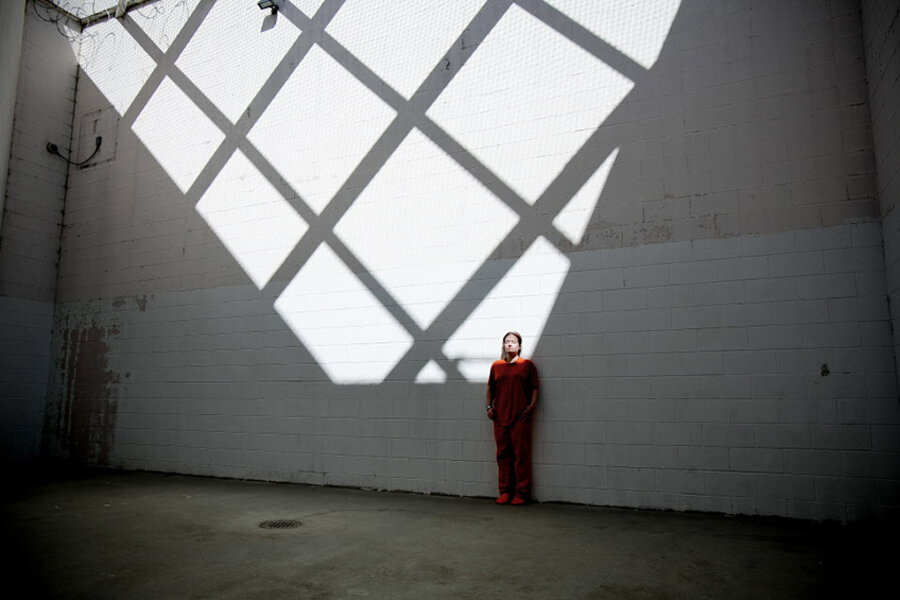Why New Jersey incarcerates more people than Rwanda
Despite a growing push for criminal justice reform, a new report reveals that incarceration rates in nearly every individual American state far outstrip those of most countries around the world.
With 1,196 people behind bars for every 100,000 people, the District of Columbia has the highest incarceration rate of countries with a population of more than half a million, exceeding even the United States itself, says a report released Thursday by the Massachusetts-based Prison Policy Initiative, a think tank aimed at highlighting the impact of mass incarceration.
While the Obama administration has made reforming the criminal justice system a priority, and public opinion has begun shifting away from the tough-on-crime policies that took hold in the 1970s and '80s, advocates say the report shows efforts to revamp how we deal with crime in the US are still a work in progress.
New Jersey ... and Rwanda?
"A lot of the countries that we consider our allies have similar crime rates. So I think it really shows that we're very excessive in terms of our use of incarceration and that it doesn't have to be this way," says Alison Walsh, the policy and communications associate at PPI, who co-authored the report.
"We could look at other policies that focus more on rehabilitation and addressing the root causes of incarceration instead of just making incarceration the default response to crime," she adds.
For example, even as many people are sentenced or await trial in connection with Rwanda's 1994 genocide, that country’s incarceration rate is slightly less than that of New Jersey, PPI found: for each of New Jersey's 100,000 residents, it locks up 441. In Rwanda, the rate is 434.
Does public opinion fuel policy?
PPI's report also comes amid a broader shift in public opinion on criminal justice, says Peter Enns, author of the book "Incarceration Nation: How the United States Became the Most Punitive Democracy in the World."
"My research suggests that the change in political rhetoric is likely following public opinion rather than leading it. Basically, the link is as the crime rate went up through the '60s, '70s, '80s, the public was becoming more punitive," a change that also prompted a move toward harsher sentencing rules, says Dr. Enns, an associate professor of government at Cornell University.
At the time, he says, media coverage often focused on sensationalistic crimes, with little pushback. "Nobody was saying, 'Hey, look at how high our incarceration rate is, let's think about it as a society and the … economic, social or political consequences.' So [tough on crime attitudes] just kept going up."
But that's begun to change as the crime rate has declined since the 1990s, with more coverage from advocacy groups and media organizations such as The Marshall Project, a news website that focuses specifically on criminal justice issues.
That could have a lasting effect, he says. "If media starts talking about innocent people being convicted, and … the effectiveness of drug treatment instead of imprisonment, then more crime doesn't automatically translate to more punitive attitudes," says Enns.
Of US states, Vermont and Massachusetts have the lowest incarceration rates in the country: 347 people and 330 people per 100,000, respectively. But if they were independent nations, PPI found, they would be the 11th and 12th highest users of incarceration across the globe.
As it is, Brazil comes in 11th, with Iran not far behind, at 17th. China? 95th. The US average, meanwhile, takes first place, with 693 inmates per 100,000 people. By comparison, the Soviet Union in 1991 incarcerated 268 people per 100,000 residents.
D.C.'s unwanted No. 1 status
The fact that the nation's capital is potentially the world leader in use of incarceration isn't surprising to Deborah Golden, an attorney who directs the DC Prisoners' Rights Project at the Washington Lawyers Committee for Civil Rights and Urban Affairs.
"Many people don't realize how bad we are compared to the rest of the world," she says. "Nobody's going to hold up the Russian Federation as a poster child for civil rights and freedom, but they have an incarceration rate that's so much lower than D.C."
In addition to many people serving lengthy sentences, Congress's decision beginning in the late 1990s to assume control over people sentenced to felonies also had a significant impact. Now, people convicted of felonies can be sent to federal prisons across the country, notes Mr. Wagner of PPI.
Federal officials often attempt to keep prisoners closer to home, but federal oversight has also led to harsher policies. Parole decisions, for example, are overseen by officials appointed by the president, not by people with local ties, Ms. Golden says.
That's significant, she says, because more than a quarter of the people in local jails in the district are incarcerated for so-called technical violations, such as failing to tell a parole officer about a new address.
Congressional influence over the nation's capital has also impacted the progress of drug laws, she notes. While possessing a small amount of marijuana is now legal in the District, city officials have been unable to further regulate marijuana sales. That means that D.C. has been unable to join several other states that use taxes on marijuana to fund programs such as substance abuse treatment.
"I think that the city of D.C. would have much more progressive policies if it wasn't for congressional interference," Golden says.
By making direct links between individual states and the rest of the world, PPI also hopes its report could provide a further wake-up call for policymakers, says Wagner.
"There's a real need [for lawmakers] to step back and say, 'What are we doing, and what kind of society is our state building,'" he says. "Have these assumptions that we've been using over the last two or three decades, are they bearing fruit, and is a fruit that we want to be producing?"






